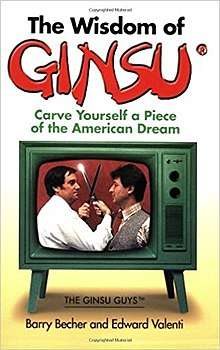Ginsu
Ginsu (/ˈɡɪnsuː/) is a brand of direct marketed knives that was made popular in the United States by being sold on television using infomercials characterized by hawker and hard sell pitch techniques. The ads fueled sales of between two and three million Ginsu sets between 1978 and 1984.

History
Ginsu knives were originally called Quikut, made by the Quikut division of Scott Fetzer Company and was located in Fremont, Ohio. Since "Quikut" lacked panache, Ed Valenti, Barry Becher, and copywriter Arthur Schiff created a name that alluded to the exceptional sharpness and durability of Japanese samurai swords. As Valenti told the Palm Beach Post in 2011, "The challenge was to position the product so that it made every other knife you owned obsolete."[1]
The resulting Ginsu ads copied the hard sell direct marketing techniques of carnival hawkers pioneering TV pitchman Ron Popeil had adapted to the medium in the 1960s. In the process, they helped solidify the formula for the modern infomercial. The ads were ubiquitous in the late 1970s on U.S. television. Advertisements for the "amazing" Ginsu knife asked, "Now how much would you pay? Don't answer!" urged viewers to "Call now! Operators are standing by!", and included the signature "But wait! There's more!", which became a popular infomercial catch phrase, and has been used ever since.[1]
Media scholar Robert Thompson, of Syracuse University, called the Ginsu advertising campaign "the pitch of all pitches."[1] "Ginsu has everything a great direct-response commercial could have," said John Witek, a marketing consultant and author of Response Television: Combat Advertising of the 1980s. "Ginsu had humor, demonstration, and a precisely structured series of premium offers I call 'the lots-for-a-little approach'."[2][3]
Valenti and Becher later repeated the advertising formula with other products such as the Miracle Slicer, Royal Durasteel mixing bowls, Vacufresh storage containers, the Chainge Adjustable Necklace, and Armourcote Cookware.[1] TV pitchmen Billy Mays and Vince Offer employed the hard-sell informercial to great success in more contemporary times.
While the name Ginsu was invented by Becher, Becher later translated the word as meaning "I never have to work again".[4] In April 2009, a stretch of road in Warwick, Rhode Island, which passes the office of Ed Valenti was named "Ginsu Way".[5]
The knife brand gained notoriety in 1993 when Lorena Bobbitt used a Ginsu kitchen knife to sever her husband's penis[6] while he slept.
Ginsu brand in the 2010s
As of 2018, Ginsu knives are still manufactured and sold. The Quikut and Ginsu brands have both been manufactured in Walnut Ridge, Arkansas, since the merging of the Douglas (vacuum cleaners) and Quikut (knives) operating units of Scott Fetzer merged subsequent to 1985. Douglas Quikut also manufactures ReadiVac and American Angler brands.
In 2013, Consumer Reports reviewed the Ginsu Chikara knife set in their comparison of fifty knife sets and rated it as their "Best Buy".[7][8][9]
References
- Quoted in obituary of Barry Becher, The Washington Post (DC), June 28, 2012, p. B6.
- Reynolds, Bill (December 12, 1982), "GINSU! It came from Warwick – it devoured the marketing world", Sunday Journal Magazine, p. 3
- Auchmutey, Jim (1983), "But wait, there's more!", Advertising Age Special Report, p. 1.
- Hevesi, Dennis (30 June 2012). "Barry Becher, a Creator of Ginsu Knife Commercials, Dies at 71". The New York Times. Retrieved 8 March 2013.
- "But wait, there's more! Call that road Ginsu". Associated Press. 2009-04-03. Retrieved 2009-04-04.
- SIMON, ROGER. "Was Lorena Bobbitt's act 'an irresistible impulse?'". baltimoresun.com. Retrieved 2020-01-06.
- http://www.consumerreports.org/cro/home-garden/kitchen/kitchen-knives/kitchen-knives-ratings/ratings-overview.htm
- DiClerico, Daniel. "In Consumer Reports' tests of cut-rate knives, Ginsu skewers Ronco". Yahoo!.
- http://www.thetruthaboutknives.com/2013/08/consumer-reports-kenji-lopez-alts-kitchen-knife-video-shootout/
Further reading
- Becher, Barry; Ed Valenti (2005), The Wisdom of Ginsu: Carve Yourself a Piece of the American Dream, Franklin Lakes, NJ: Career Press, ISBN 1-56414-803-3
- Isabel Gottlieb (2008-03-07). "30 Years Later, This Iconic Knife Still Carving Its Name". Features. Brown Daily Herald. Archived from the original on 2008-06-01.
- Reynolds, Bill (December 12, 1982), "GINSU! It came from Warwick – it devoured the marketing world", Sunday Journal Magazine, p. 3.
- Auchmutey, Jim (1983), "But wait, there's more!", Advertising Age Special Report, p. 1.
- Smith, Andy (March 28, 2005), "But wait, there's more!", Providence Journal, p. 1.
- Ron Popeil, Philip Kives, Ed Valenti and Barry Becher, Robert Thompson, among others (2003). Gadget Mania: The History and Evolution of the Informercial (DVD). Discovery Communications, Inc.